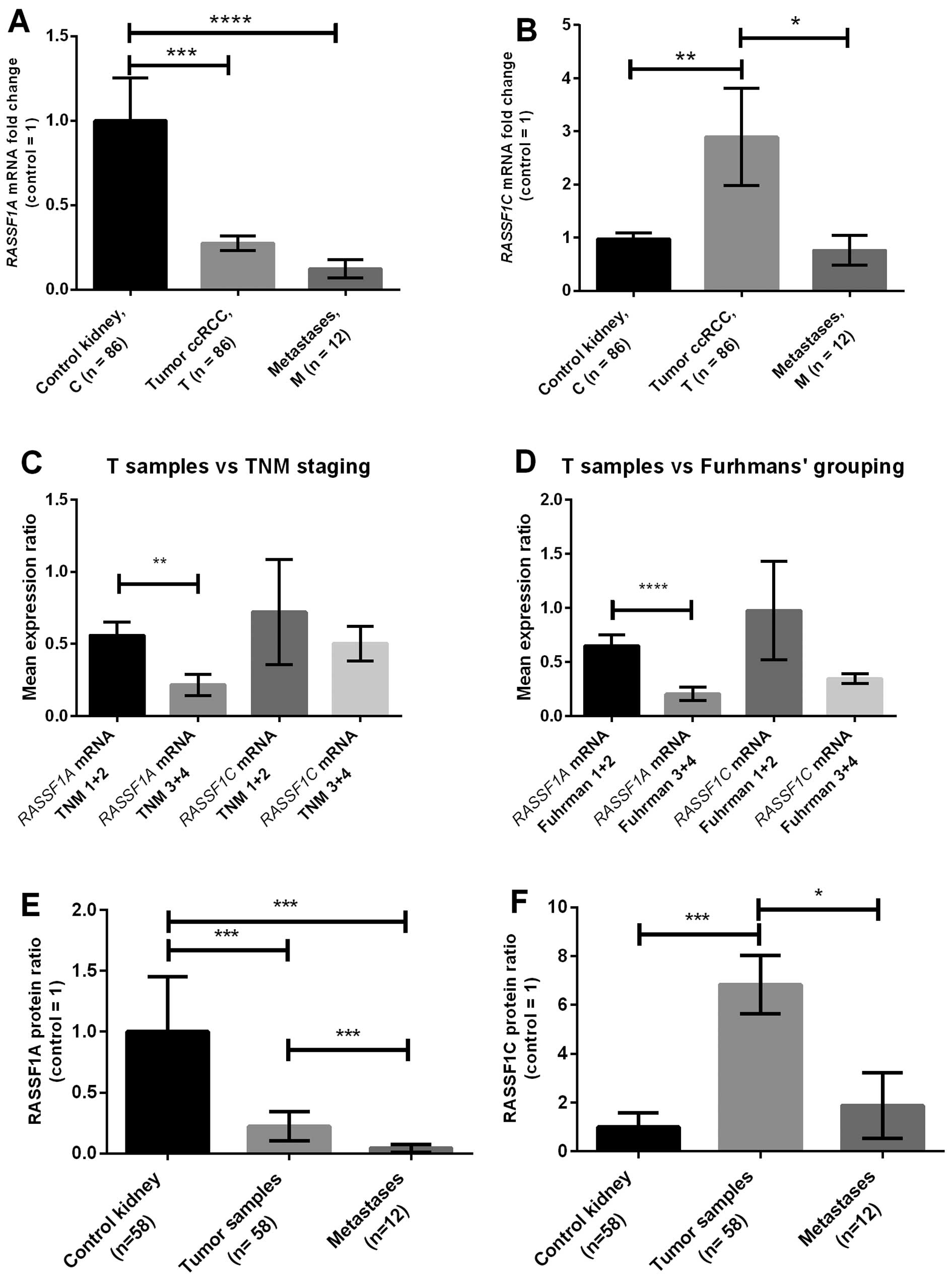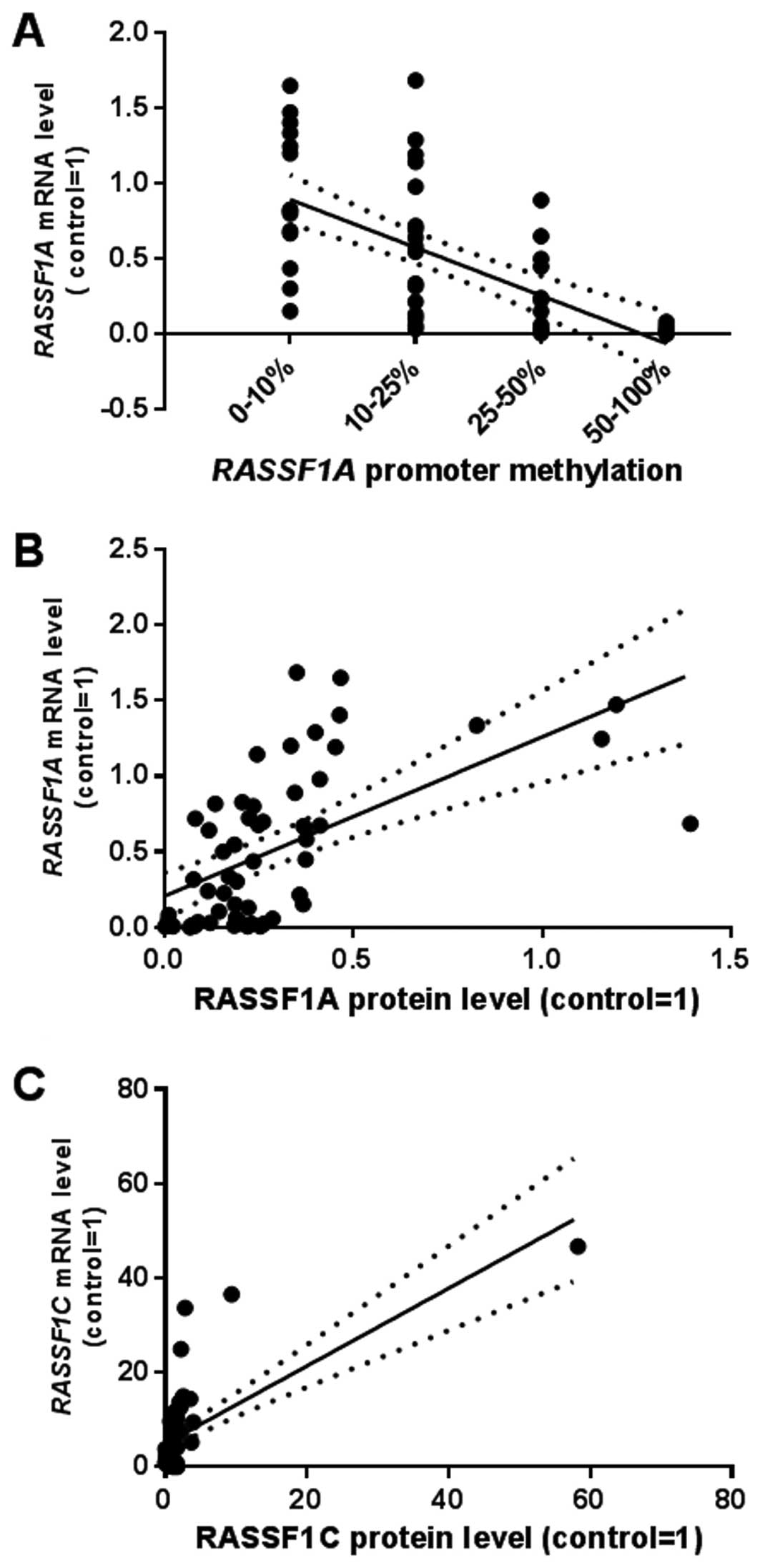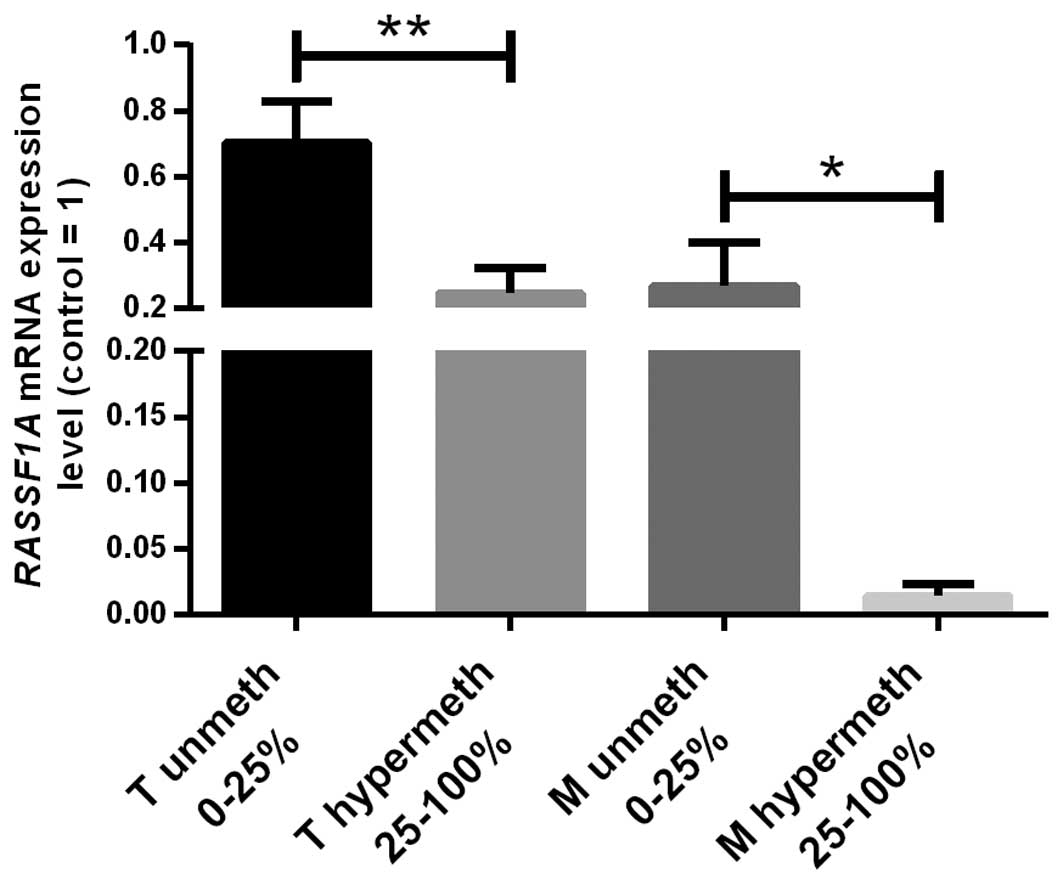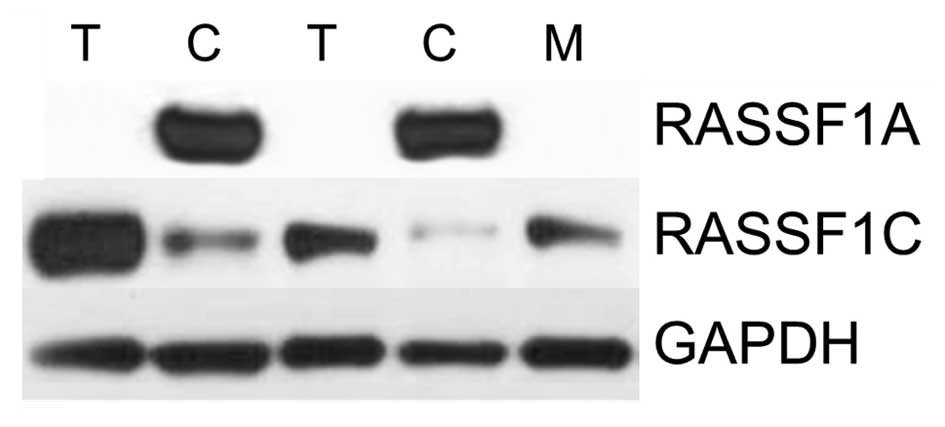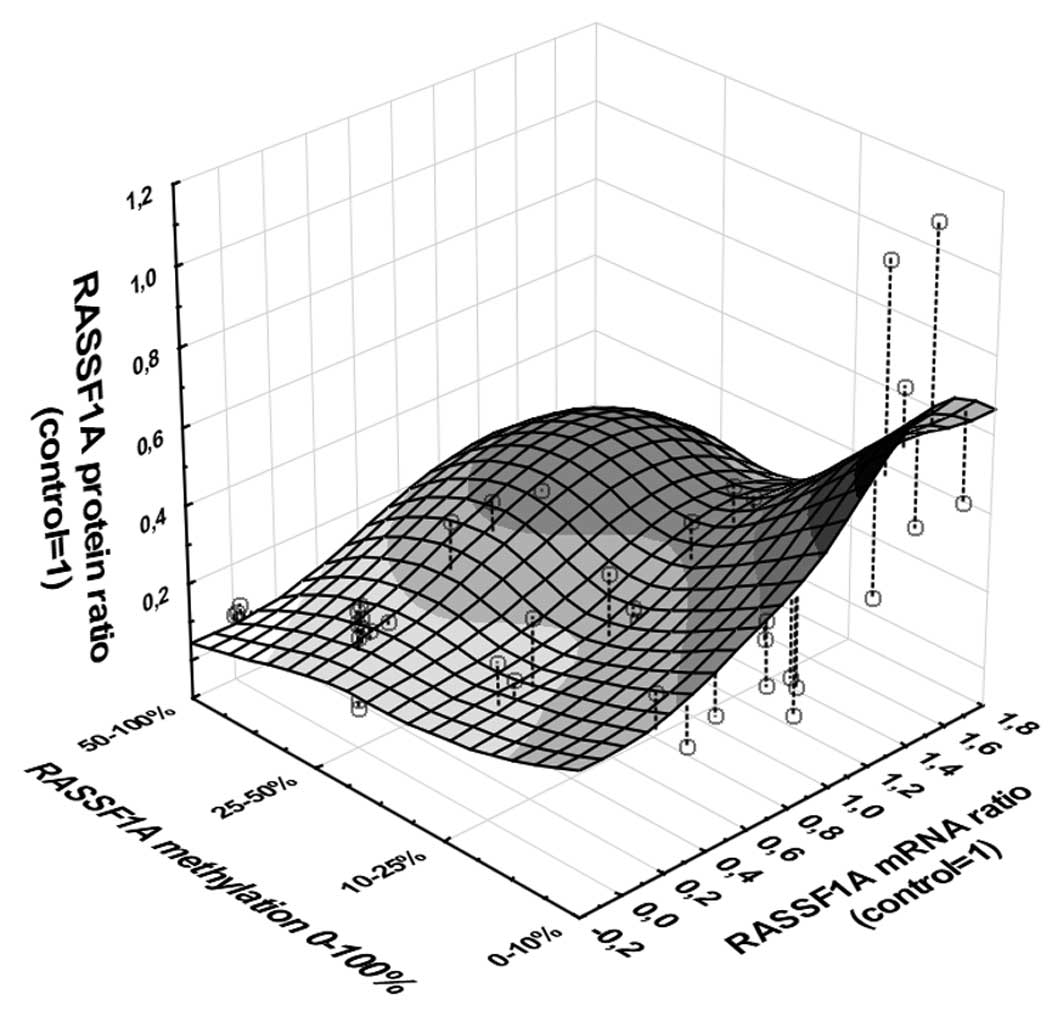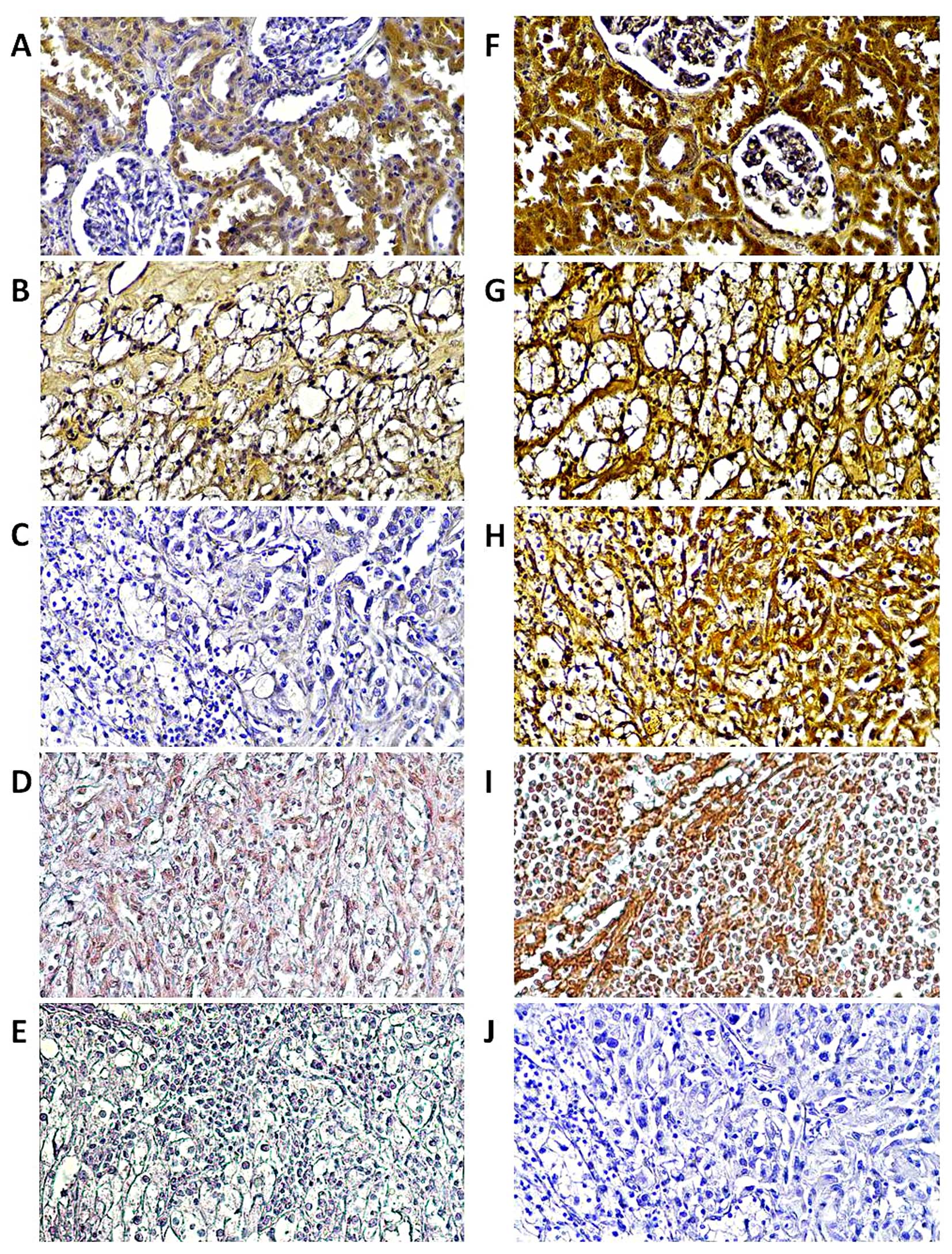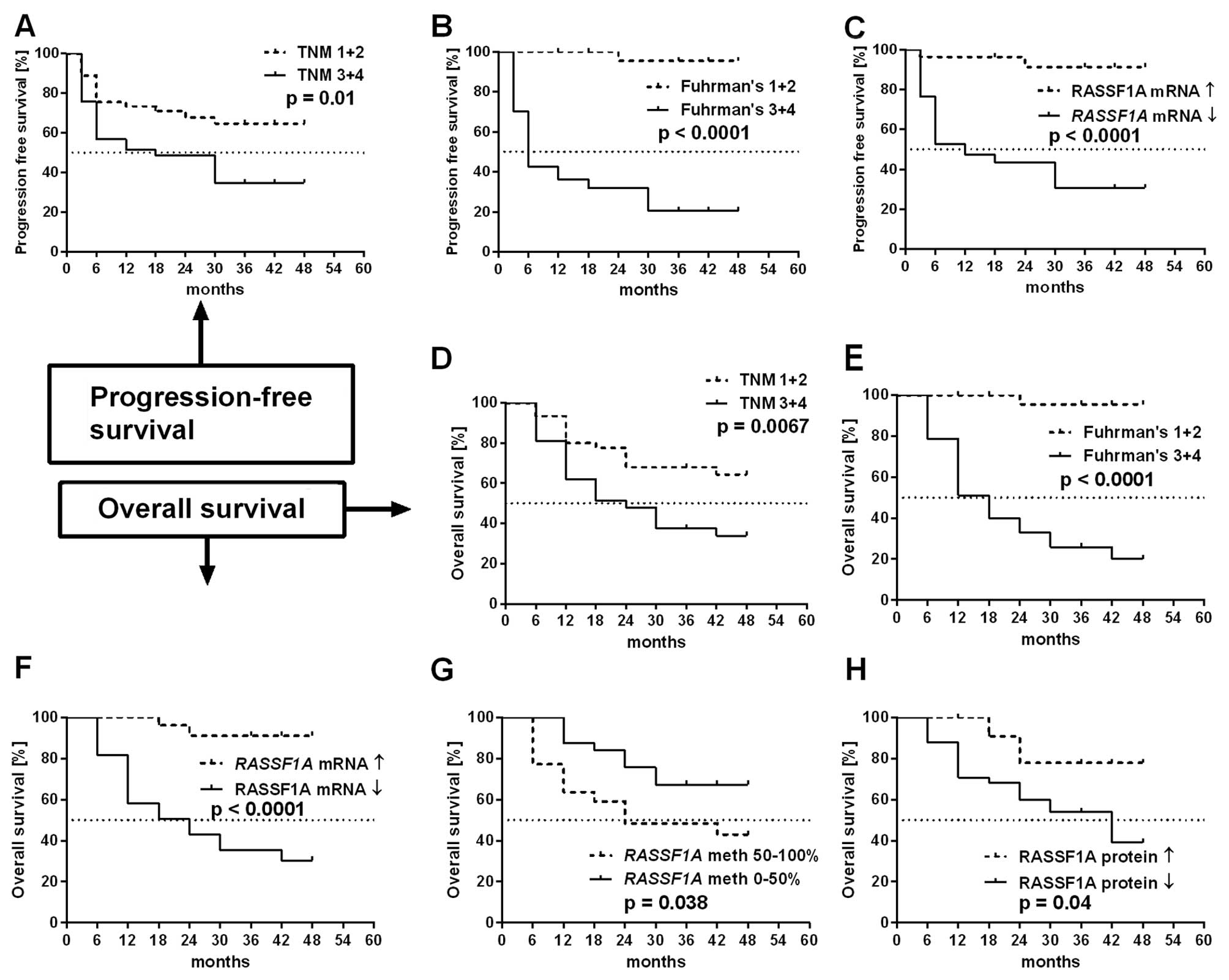Decreased expression of RASSF1A tumor suppressor gene is associated with worse prognosis in clear cell renal cell carcinoma
- Authors:
- Published online on: November 18, 2015 https://doi.org/10.3892/ijo.2015.3251
- Pages: 55-66
-
Copyright: © Klacz et al. This is an open access article distributed under the terms of Creative Commons Attribution License.
Abstract
Introduction
Clear cell renal carcinoma (ccRCC) is the most frequent RCC subtype and is characterized by high mortality of 40 within 5 years, due to late diagnosis and distant metastases found in 30 (1) to 80 (2) of RCC patients at a time of examination or within the course of the disease. Among patients who undergo radical resection for clinically localized disease, future meta-static disease will develop in 20–40 of the ccRCC cases (3). The search for new molecular targets is continuing due to high mortality rate of advanced RCC (4).
The 3p chromosomal region contains tumor suppressor genes (TSG) whose downregulation is involved in cancer progression: VHL (5), FHIT (6) and RASSF1 (7). RASSF1 [Ras association (RalGDS/AF-6) domain family member 1] gene encodes RASSF1A and RASSF1C proteins which function as intracellular signal transducers (8). RASSF1A mRNA levels were decreased in at least 37 types of tumors (8) with promoter hypermethylation as the common mechanism of its underexpession (9).
Since no quantitative analysis of RASSF1A gene expression has yet been performed in ccRCC we decided to assess RASSF1A mRNA and protein levels in tumor, normal kidney tissue and metastases. We also analyzed the methylation status of RASSF1A promoter by a novel quantitative technique. Moreover, we checked mRNA and protein levels of RASSF1C gene in matched tumor-normal kidney and metastasized samples of ccRCC patients.
Materials and methods
Patients and samples
Tissue samples were collected from 86 ccRCC patients who underwent radical nephrectomy at the Department of Urology, Medical University of Gdansk, Poland, between January 2011 and September 2013. The clinical data of patients is presented in Table I. The study was approved by the local ethics committee; written consent was obtained before the surgery from each patient.
Sample acquisition
Samples were obtained according to our previous report (10) with some modifications. Briefly, dissected tissue samples of primary ccRCC tumor (n=86, named T), normal kidney (n=86, named C as controls) and adrenal gland or the whole lymph node (n=12, named M), were collected in the operating room and placed immediately in approximately five volumes of RNAlater (Ambion Inc., Austin, TX, USA).
RNA isolation and cDNA synthesis
We utilized the same methodology as previously described (10) with some modifications. In short, ExtractMe Total RNA kit (DNAGdansk, Gdansk, Poland) was used for RNA extraction, followed by spectro-photometric (NanoDrop ND-1000; Thermo Fisher Scientific, Fitchburg, WI, USA) and electrophoretic (Bioanalyzer 2100 apparatus; Agilent Technologies, Santa Clara, CA, USA) analysis of RNA. After DNA removal (Turbo DNA-free kit; Ambion, Austin, TX, USA), 2 μg total RNA was reversibly transcribed with the use of RevertAid reverse transcriptase (Fermentas-Thermo Fischer Scientific) and 0.5 μg dT18 primers (Sigma-Aldrich, Munich, Germany) in a total volume of 20 μl.
Assessment of RASSF1A and RASSF1C mRNA expression
Quantitative real-time PCR (qPCR) technique was applied to measure mRNA level of RASSF1A and RASSF1C genes in all samples after normalization to the GUSB reference gene level in each sample (10). List of primers and details regarding time-temperature protocol are described in Table II. All reactions were run in duplicate using 1 μl of 4X diluted cDNA and SensiFast Sybr™ No-ROX kit (BioLine, London, UK) chemistry in a total volume of 10 μl. Each gene assay was run on a separate plate (StepOnePlus apparatus; Life Technologies-Applied Biosystems, Grand Island, NY, USA) with non-template control (water instead of cDNA) and 10X diluted pooled cDNA as a run-to-run precision control. Data was acquired by StepOne Software ver. 2.2 and geometric mean of Ct (threshold cycle) values were used for comparable expression analysis. The Livak's method was utilized for quantification: Ratio = 2−ΔΔCt to obtain raw expression data for each sample, followed by calibration to average expression data of control samples (fold change; control sample = 1).
Table IIClinicopathological features of ccRCC patients and association between RASSF1A and RASSF1C mRNA levels and clinical data. |
DNA extraction, bisulfite modification and acquisition of control DNA
DNA was isolated from each specimen (~2 mg) to a total volume of 20 μl followed by bisulfide modification according to manufacturer's protocol (DNA Methylation-Direct™ kit; Zymo Research, Irvine, CA, USA). Final elution was performed with the use of 50 μl of ddH2O, and the DNA concentration was assessed with NanoDrop ND-1000. For the generation of a dilution series of control DNA standards, fully methylated (named MD) and unmethylated (UMD) human genomic DNA (HCT116 cell line, DKO strain, Human Methylated & Non-methylated DNA Set; Zymo Research) were utilized.
Methylation sensitive high resolution melting quantitative PCR (MS-HRM-qPCR) assessment of RASSF1A promoter methylation status
Methylation was assessed in samples with the use of methylation specific-high resolution melting (MS-HRM) (9). Primers sequences were designed using MethPrimer software (http://www.urogene.org/methprimer/); primers, reaction mixtures and time-temperature conditions are listed for each promoter region interrogated in Table I. MS-qPCR reactions were set on StepOnePlus (Life-Technologies) apparatus and after conventional 42-cycle amplification, post-PCR products were checked using HRM application (details in Table I) with the use of HRM software ver. 3.1 (Life-Technologies). For each run, matched DNA from T, C and M samples were set; standard dilutions of MD and UMD were made to 100, 50, 25, 10 and 0% of MD in UMD and used in the same PCR plate as well as no template control. The final methylation results divided samples into two groups: homogenous and heterogenous methylated DNA; homogenous DNA was further semi-quantitatively divided into intervals, according to MD standards (0–10%; 10–25%; 25–50% and 50–100%). Heterogenously methylated DNA samples were excluded from the analysis, due to limitation of the method (9,11).
Western blot analysis
Protein lysates were prepared with Mammalian Cell Extraction kit (BioVision, Milpitas, CA, USA). The lysates (10 μg) were loaded to a 10% Mini-Protean TGX gel (Bio-Rad Laboratories, Hercules, CA, USA), resolved by SDS-PAGE and transferred to a PVDF membrane using the Trans-Blot Turbo system (Bio-Rad Laboratories). Membranes were stained with 0.1% Ponceau S to ensure equal loading after transfer, and subsequently blocked with 5% albumin fraction V in TBS buffer with 0.1% Tween-20 (TBST) for 1 h at room temperature (RT). After washing with TBST, membranes were incubated (overnight, 4°C) with specific primary antibodies in 2% albumin/TBS: 1:2,000 rabbit anti-RASSF1A (#bs-1234R; Bioss, Inc., Woburn, MA, USA); mouse polyclonal anti-RASSF1C (1:1,000) (#ab24419; Abcam, Cambridge, UK) and anti-GAPDH peroxidise-conjugated IgM 1:50,000 (#G9295; Sigma-Aldrich, St. Louis, MO, USA). After triple washing with TBST, blots were incubated (2 h, RT) with horseradish peroxidase-conjugated secondary antibodies: 1:15,000 anti-rabbit IgG or anti-mouse IgG (Sigma-Aldrich). Following triple washing with TBST, immunoreactive bands were detected on medical X-ray film (Agfa HealthCare, Mortsel, Belgium) using chemiluminescent peroxidase substrate (Sigma-Aldrich). Densitometric analyses of immunoreactive protein bands was performed with Quantity One software (Bio-Rad Laboratories) and calculated as units = Intensity/mm2. After normalization to GAPDH protein units for each sample, the semi-quantitate results for either tumor or metastasized samples were obtained as a ratio = mean unitsT/M/mean unitsC for RASSF1A or RASSF1C proteins.
Immunohistochemistry for RASSF1A and RASSF1C proteins
Formalin-fixed paraffin-embedded tissue sections (6 μm) from side tissues were deparaffinized and hydrated through xylenes and graded alcohol series. After antigen retrieval using hot acidic citrate buffer (Epitope Retrieval Solution pH 6.0; Leica Biosystems Newcastle Ltd., Newcastle upon Tyne, UK) samples were blocked for endogenous peroxidase activity by using 3% hydrogen peroxide for 10 min. Sections were then incubated with 2.5% normal horse serum [ImmPRESS anti-rabbit Ig (peroxidase) polymer detection kit; Vector Laboratories, Inc., Burlingame, CA, USA] to block non-specific binding of immunoglobulin. Immunohistochemical (IHC) staining was performed using anti-RASSF1A rabbit anti-human polyclonal antibody (1:100) (#bs-1234R; Bioss, Woburn, MA, USA) or mouse polyclonal anti-RASSF1C (1:100) (#ab24419; Abcam). After 2-h incubation with primary antibodies at room temperature, slides were washed in PBS and incubated with an appropriate secondary antibody [ImmPRESS anti-rabbit Ig (peroxidase) polymer detection kit or ImmPRESS anti-mouse Ig (peroxidase) polymer detection kit] for 30 min. Slides were rinsed in PBS and immunoreactive cells were visualized by addition of 3,3′-diaminobenzidine solution (DAB peroxidase substrate kit; Vector Laboratories) and counterstained with hematoxylin. Sections were then dehydrated, mounted in DPX mounting medium and viewed under a Nikon Eclipse E800 light microscope with Lucia G software. The specificity of the IHC staining was determined by a negative control, which was prepared under the same conditions as mentioned above, replacing primary antibodies with 2.5% normal horse serum [ImmPRESS anti-rabbit Ig (peroxidase) polymer detection kit].
Statistical analysis
Statistics was performed with the use of GraphPad Prism ver. 6.05 (GraphPad Software, Inc., San Diego, CA, USA) and Statistica ver. 10c (Statsoft Inc., Tulsa, OK, USA). Non-parametric Mann-Whitney U and Kruskal-Wallis ANOVA tests were used to compare clinical and molecular data since most data did not pass D'Agostino and Pearson omnibus test. Fisher's 2×2 exact test was used to analyse relationships between the subgroups. Spearman's correlation or multivariate regression were utilized for testing the associations between two or three variables. The Cox-Mantel proportional hazard regression model was used to evaluate the effect of explorative variables on survival of ccRCC patients. First, univariate Cox regression analysis for every single variable was performed. Secondly, variables with a P-value <0.05 were included into multivariate Cox regression analysis with a variable selection via backward elimination. All associations were presented as hazard ratios (HR) with their 95% confidence interval (CI) and P-values (12). Variables for overall survival (OS) and progression-free survival (PFS) rates were calculated separately. Kaplan-Meier estimations were performed to describe survival rates.
Results
Clinicopathological characteristics of patients
Of 86 ccRCC patients (mean age, 62.1±11.2 years) (Table II), 37 were diagnosed as stage I (T1-2N0M0), 8 as stage II (T2N0M0), 12 as stage III (T1-2N1M0 or T3N0-1M0) and 29 as stage IV (T4N0-2M0 or T1-4N2M0 or T1-4N0-2M1). At the time of surgery 47.7% ccRCC patients were diagnosed with local or distant metastases. According to Fuhrman's nuclear grading 4 patients were grade 1, 32 grade 2, 23 grade 3 and 26 were grade 4. None of the patients had undergone chemotherapy or radiotherapy before the nephrectomy. The mean follow-up period was 21 months (range, 3–48), to date 45 patients were alive (52); all deaths (except for 1 patient) were related to ccRCC progression. Median overall survival (OS) rate was 12 months. During follow-up metastases occurred in 38 (44) patients while the median progression free-survival (PFS) rate was 6 months.
Expression of RASSF1A and RASSF1C genes at the mRNA level
As shown in Fig. 1A, RASSF1A mRNA level in T and M samples were ~4 and 5 times lower vs. C samples, respectively. The mRNA levels of RASSF1C were ~3 times higher in tumor in comparison to either C or M samples, respectively (Fig. 1B).
After setting-up the threshold value based on median values of RASSF1A or RASSF1C expression levels in control samples decreased level of RASSF1A mRNA was noted in 66 of T and 75 of M samples, whereas RASSF1C expression was upregulated in 76 T and 33 M samples.
Patients with higher nuclear grades (Fuhrman's 3+4) and metastatic ccRCC (TNM 3+4) showed downregulation of RASSF1A (Table II). The mRNA levels of RASSF1A were ~3 and 4 times lower in TNM 3+4 and Fuhrman's 3+4 than in TNM 1+2 or Fuhrman's 1+2 groups, respectively (Fig. 1C and D). No correlations between clinical data and RASSF1C gene expression were found (Table II and Fig. 1C and D).
RASSF1A promoter methylation status
According to the analysis of MD/UMD standards the results of HRM-MS-qPCR were qualified into four grades: 1, 0–10% methylation; 2, 10–25%; 3, 25–50%; 4, 50–100% (data not shown). We assessed >25% methylation as hypermethylation status finding 35 (60%) unmethylated and 23 (40%) hypermethylated T samples. A significant negative correlation between increasing grades of methylation and RASSF1A mRNA levels was found (Fig. 3). In hypermethylated T samples ~3.5 times lower RASSF1A mRNA level than in non-methylated T cases was observed. Hypermethylation of RASSF1 promoter was associated only with high TNM status (Table III).
Table IIIAssociation between RASSF1A promoter methylation, protein expression of RASSF1A and RASSF1C and data of patients. |
RASSF1A promoter hypermethylation was found in 5/8 of metastasized samples in which RASSF1A mRNA levels were ~15 times lower than in non-methylated metastasized samples (Fig. 2). No correlations between methylation status of metastases and clinical data were found.
RASSF1A and RASSF1C protein analysis
RASSF1A and RASSF1C protein levels were assessed by western blot analysis in paired 58 ccRCC and control samples, and 12 metastases analyzed for RASSF1A hypermethylation. The average RASSF1A protein levels in T and M samples were ~5 and 20 times lower than in control tissue, respectively (Figs. 4 and 1E). After setting-up threshold level 44/58 T (76) and 10/12 M (83) samples showed decreased RASSF1A protein level (Fig. 1E and Table III). Decreased RASSF1A level in tumor samples was associated with higher Fuhrman's grade and high TNM grades (Table III).
RASSF1C protein level was on average ~6 times higher in T vs. C samples with similar levels in M and C (Figs. 4 and 1F). However, high RASSF1C level was found only in 10/58 (20) T and 3/12 (25) M samples (Fig. 1F and Table III).
Positive correlations were observed between mRNA and protein levels (rs=0.66 for RASSF1A and rs=0.69 for RASSF1C; P<0.001, Spearman's test).
The analysis of possible indirect association between RASSF1A promoter methylation → decreased mRNA level → decreased protein level revealed significant relationship between three measured variables (multivariable regression; P<0.001, b=−0.63; Fig. 5).
Tissue localization of RASSF1A and RASSF1C proteins
Immunohistochemical staining for RASSF1A and RASSF1C proteins was performed on twelve paired T and C samples and six M samples. As presented in Fig. 6, both proteins showed intense immunoreactivity in epithelial cells of healthy kidney whereas in tumor and metastasized samples RASSF1A was barely noticeable (Fig. 6B–D). Strong immunoreactivity of the RASSF1C protein was found in all studied samples (Fig. 6F–I).
Survival analysis
We found that overall and progression-free survival were strongly associated with higher TNM and Fuhrman's grades of ccRCC patients (Fig. 7A, B, D and E). Patients with decreased RASSF1A mRNA levels showed significantly shorter OS and PFS rates than patients with high RASSF1A mRNA levels (Fig. 7C and F). Furthermore, higher RASSF1A promoter methylation status and lower RASSF1A protein levels were associated with shorter OS (Fig. 7G and H).
It was noted, that the levels of RASSF1C were not associated with either OS or PFS rates of ccRCC patients (plots not shown).
Multivariate analysis using the Cox proportional hazard model indicated that the classification based on RASSF1A mRNA level was the independent predictor of OS and PFS in ccRCC patients when assessed by Fuhrman's histological grade (Tables IV and V).
Table IVUnivariable and multivariable Cox regression analysis of overall survival rate of ccRCC patients. |
Table VUnivariable and multivariable Cox regression analysis of progression free-survival rate of ccRCC patients. |
Discussion
RASSF1A has been suggested to function as a tumor suppressor gene: its decreased expression at mRNA or protein levels was observed in almost all studied human cancers (8,13,14), however, only a few groups were analyzed for its role in ccRCC.
To the best of our knowledge, the present study is the first report of decreased RASSF1A mRNA levels in ccRCC. To date, the decreased RASSF1A expression assessed by the QPCR method in ovarian cancer (15), non-small cell lung cancer (NSCLC) (16), breast and lung cancers (17) and esophageal squamous cell (ESCC) (18) was associated with progression of cancer and poor patient outcome (15,16,18). Thus, lower transcription of RASSF1A seems to be a wider phenomenon.
Epigenetic alterations occur frequently in various cancer types with hypermethylation of the CpG islands being a frequent cause of gene silencing. Unexpectedly, when we assessed hypermethylation of RASSF1A promoter region in ccRCC, we found a relatively low number of hypermethylated tumor samples, probably due to high DNA heterogeneity in ccRCC tissue as observed by other groups (19,20). Although other authors reported high association of RASSF1A methylation with increased risk of RCC, it has to be noted that this was attributed only to serum DNA but not cancer tissue (21). In the present study probably the more homogeneous histology of twelve ccRCC metastasized samples resulted in the increased OR similarly to data on serum DNA (22–24). In other malignancies the hypermethylation of RASSF1A was related to the progression of breast (25), NSCLC (26), prostate (7), pancreatic (27), ESCC (18) and colorectal (28) cancers.
The reliable measurement of the gene expression should involve at least two levels of quantification, since the DNA → mRNA → protein sequence often becomes deregulated in cancer cells (29). The analysis of protein level is necessary for the realistic evaluation of alterations of the gene expression both in normal and cancer tissues. The decreased levels of RASSF1A in ccRCC described in the study present a novel observation. The finding of the relation between low levels of RASSF1A in ccRCC samples and progression of cancer (TNM and Fuhrman's grading) support the role of RASSF1A as a tumor suppressor gene also in ccRCC, similarly to other types of cancer (30,31).
The immunohistochemical evaluation of protein expression in tissue sections is a standard method in cancer studies. Our qualitative observations of decreased RASSF1A immunoreactivity in ccRCC tissue are in line with the results of the tissue microarrays (TMA) study which showed that low RASSF1A tissue expression was associated with poorer outcome (32). Other authors found that downregulation of RASSF1A immunoexpression was associated with early RCC formation (19).
We present novel data on the RASSF1C expression at mRNA and protein level in ccRCC. Their increased expression in ccRCC did not correlate with cancer progression on the contrary to breast cancer and ESCC (18,33). Thus, RASSF1C expression probably does not play oncogenic role in ccRCC. The epigenetic methylation does not play any role in RASSF1C gene expression since its promoter region does not contain CpG islands (27).
In conclusion, the results of the present study suggest that measurement of RASSF1A mRNA levels in paired tumor-normal kidney tissue could be used as a new prognostic factor in ccRCC, whereas the involvement of RASSF1C gene in ccRCC progression was not confirmed.
Acknowledgements
The present study was supported by the National Science Centre (grant no: 2012/05/B/NZ4/02735); the Ministry of Science and Higher Education (grant IP2010 045970 and grant no: GUMed: 02-017/07); the system project ‘InnoDoktorant-Scholarships for Ph.D. students, VIth edition’. The project is co-financed by the European Union in the frame of the European Social Fund. Authors wish to thank Michal Czarniak, for the laboratory support.
References
|
Novara G, Martignoni G, Artibani W and Ficarra V: Grading systems in renal cell carcinoma. J Urol. 177:430–436. 2007. View Article : Google Scholar : PubMed/NCBI | |
|
Massari F, Bria E, Maines F, Milella M, Giannarelli D, Cognetti F, Pappagallo G, Tortora G and Porta C: Adjuvant treatment for resected renal cell carcinoma: Are all strategies equally negative? Potential implications for trial design with targeted agents. Clin Genitourin Cancer. 11:471–476. 2013. View Article : Google Scholar : PubMed/NCBI | |
|
Keizman D, Rouvinov K, Sella A, Gottfried M, Maimon N, Kim JJ, Eisenberger MA, Sinibaldi V, Peer A, Carducci MA, et al: Is there a ‘trial effect’ on outcome of patients with meta-static renal cell carcinoma treated with sunitinib? Cancer Res Treat. Mar 5–2015. View Article : Google Scholar : (Epub ahead of print). | |
|
van der Mijn JC, Mier JW, Broxterman HJ and Verheul HM: Predictive biomarkers in renal cell cancer: Insights in drug resistance mechanisms. Drug Resist Updat. 17:77–88. 2014. View Article : Google Scholar : PubMed/NCBI | |
|
Nyhan MJ, O'Sullivan GC and McKenna SL: Role of the VHL (von Hippel-Lindau) gene in renal cancer: A multifunctional tumour suppressor. Biochem Soc Trans. 36:472–478. 2008. View Article : Google Scholar : PubMed/NCBI | |
|
Haroun RA, Zakhary NI, Mohamed MR, Abdelrahman AM, Kandil EI and Shalaby KA: Assessment of the prognostic value of methylation status and expression levels of FHIT, GSTP1 and p16 in non-small cell lung cancer in Egyptian patients. Asian Pac J Cancer Prev. 15:4281–4287. 2014. View Article : Google Scholar : PubMed/NCBI | |
|
Daniunaite K, Jarmalaite S, Kalinauskaite N, Petroska D, Laurinavicius A, Lazutka JR and Jankevicius F: Prognostic value of RASSF1 promoter methylation in prostate cancer. J Urol. 192:1849–1855. 2014. View Article : Google Scholar : PubMed/NCBI | |
|
Chan JJ and Katan M: PLCɛ and the RASSF family in tumour suppression and other functions. Adv Biol Regul. 53:258–279. 2013. View Article : Google Scholar : PubMed/NCBI | |
|
Wojdacz TK and Dobrovic A: Methylation-sensitive high resolution melting (MS-HRM): A new approach for sensitive and high-throughput assessment of methylation. Nucleic Acids Res. 35:e412007. View Article : Google Scholar : PubMed/NCBI | |
|
Wierzbicki PM, Klacz J, Rybarczyk A, Slebioda T, Stanislawowski M, Wronska A, Kowalczyk A, Matuszewski M and Kmiec Z: Identification of a suitable qPCR reference gene in metastatic clear cell renal cell carcinoma. Tumour Biol. 35:12473–12487. 2014. View Article : Google Scholar : PubMed/NCBI | |
|
Mikeska T, Candiloro IL and Dobrovic A: The implications of heterogeneous DNA methylation for the accurate quantification of methylation. Epigenomics. 2:561–573. 2010. View Article : Google Scholar : PubMed/NCBI | |
|
Avădănei ER, Wierzbicki PM, Giuşcă SE, Grigoraş A, Amălinei C and Căruntu ID: Macrophage profile in primary versus secondary liver tumors. Folia Histochem Cytobiol. 52:112–123. 2014. View Article : Google Scholar | |
|
van der Weyden L and Adams DJ: The Ras-association domain family (RASSF) members and their role in human tumourigenesis. Biochim Biophys Acta. 1776:58–85. 2007.PubMed/NCBI | |
|
Wierzbicki PM and Rybarczyk A: The Hippo pathway in colorectal cancer. Folia Histochem Cytobiol. 53:105–119. 2015. View Article : Google Scholar : PubMed/NCBI | |
|
Fu LJ and Zhang SL: Expression of RASSF1A in epithelial ovarian cancers. Eur Rev Med Pharmacol Sci. 19:813–817. 2015.PubMed/NCBI | |
|
Pastuszak-Lewandoska D, Kordiak J, Migdalska-Sęk M, Czarnecka KH, Antczak A, Górski P, Nawrot E, Kiszałkiewicz JM, Domańska D and Brzeziańska-Lasota E: Quantitative analysis of mRNA expression levels and DNA methylation profiles of three neighboring genes: FUS1, NPRL2/G21 and RASSF1A in non-small cell lung cancer patients. Respir Res. 16:762015. View Article : Google Scholar : PubMed/NCBI | |
|
Reeves ME, Firek M, Chen ST and Amaar Y: The RASSF1 gene and the opposing effects of the RASSF1A and RASSF1C isoforms on cell proliferation and apoptosis. Mol Biol Int. 2013:1450962013. View Article : Google Scholar : PubMed/NCBI | |
|
Guo W, Cui L, Wang C, Guo Y, Shen S, Kuang G and Dong Z: Decreased expression of RASSF1A and up-regulation of RASSF1C is associated with esophageal squamous cell carcinoma. Clin Exp Metastasis. 31:521–533. 2014. View Article : Google Scholar : PubMed/NCBI | |
|
Peters I, Rehmet K, Wilke N, Kuczyk MA, Hennenlotter J, Eilers T, Machtens S, Jonas U and Serth J: RASSF1A promoter methylation and expression analysis in normal and neoplastic kidney indicates a role in early tumorigenesis. Mol Cancer. 6:492007. View Article : Google Scholar : PubMed/NCBI | |
|
Cooper CS, Eeles R, Wedge DC, Van Loo P, Gundem G, Alexandrov LB, Kremeyer B, Butler A, Lynch AG, Camacho N, et al: Analysis of the genetic phylogeny of multifocal prostate cancer identifies multiple independent clonal expansions in neoplastic and morphologically normal prostate tissue. Nat Genet. 47:367–372. 2015. View Article : Google Scholar : PubMed/NCBI | |
|
Yu GS, Lai CY, Xu Y, Bu CF and Su ZX: Aberrant methylation of RASSF1A gene contribute to the risk of renal cell carcinoma: A meta-analysis. Asian Pac J Cancer Prev. 16:4665–4669. 2015.PubMed/NCBI | |
|
de Martino M, Klatte T, Haitel A and Marberger M: Serum cell-free DNA in renal cell carcinoma: A diagnostic and prognostic marker. Cancer. 118:82–90. 2012. View Article : Google Scholar | |
|
Onay H, Pehlivan S, Koyuncuoglu M, Kirkali Z and Ozkinay F: Multigene methylation analysis of conventional renal cell carcinoma. Urol Int. 83:107–112. 2009. View Article : Google Scholar : PubMed/NCBI | |
|
Kawai Y, Sakano S, Suehiro Y, Okada T, Korenaga Y, Hara T, Naito K, Matsuyama H and Hinoda Y: Methylation level of the RASSF1A promoter is an independent prognostic factor for clear-cell renal cell carcinoma. Ann Oncol. 21:1612–1617. 2010. View Article : Google Scholar | |
|
Hagrass HA, Pasha HF, Shaheen MA, Abdel Bary EH and Kassem R: Methylation status and protein expression of RASSF1A in breast cancer patients. Mol Biol Rep. 41:57–65. 2014. View Article : Google Scholar | |
|
Nawaz I, Qiu X, Wu H, Li Y, Fan Y, Hu LF, Zhou Q and Ernberg I: Development of a multiplex methylation specific PCR suitable for (early) detection of non-small cell lung cancer. Epigenetics. 9:1138–1148. 2014. View Article : Google Scholar : PubMed/NCBI | |
|
Malpeli G, Amato E, Dandrea M, Fumagalli C, Debattisti V, Boninsegna L, Pelosi G, Falconi M and Scarpa A: Methylation-associated down-regulation of RASSF1A and up-regulation of RASSF1C in pancreatic endocrine tumors. BMC Cancer. 11:3512011. View Article : Google Scholar : PubMed/NCBI | |
|
Wang HL, Zhang Y, Liu P and Zhou PY: Aberrant promoter methylation of RASSF1A gene may be correlated with colorectal carcinogenesis: A meta-analysis. Mol Biol Rep. 41:3991–3999. 2014. View Article : Google Scholar : PubMed/NCBI | |
|
Kristensen VN, Lingjærde OC, Russnes HG, Vollan HK, Frigessi A and Børresen-Dale AL: Principles and methods of integrative genomic analyses in cancer. Nat Rev Cancer. 14:299–313. 2014. View Article : Google Scholar : PubMed/NCBI | |
|
Joo MK, Kim KH, Park JJ, Yoo HS, Choe J, Kim HJ, Lee BJ, Kim JS and Bak YT: CpG island promoter hypermethylation of Ras association domain family 1A gene contributes to gastric carcinogenesis. Mol Med Rep. 11:3039–3046. 2015. | |
|
Hu J, Li H, Shi T, Ma X, Wang B, Xu H, Ai X, Ju Z, Wang C, Zhang G, et al: Relationship between the expression of RASSF1A protein and promoter hypermethylation of RASSF1A gene in bladder tumor. J Huazhong Univ Sci Technolog Med Sci. 28:182–184. 2008. View Article : Google Scholar : PubMed/NCBI | |
|
Tezval H, Merseburger AS, Matuschek I, Machtens S, Kuczyk MA and Serth J: RASSF1A protein expression and correlation with clinicopathological parameters in renal cell carcinoma. BMC Urol. 8:122008. View Article : Google Scholar : PubMed/NCBI | |
|
Reeves ME, Baldwin SW, Baldwin ML, Chen ST, Moretz JM, Aragon RJ, Li X, Strong DD, Mohan S and Amaar YG: Ras-association domain family 1C protein promotes breast cancer cell migration and attenuates apoptosis. BMC Cancer. 10:5622010. View Article : Google Scholar : PubMed/NCBI |



